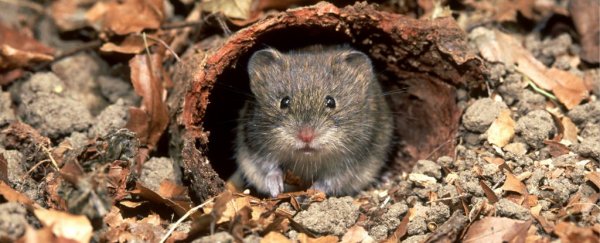Bats and pangolins aren't the only wild animals harboring novel coronaviruses. Rodents like rats, mice, and voles can also carry viruses that are sometimes capable of jumping over to our own species.
Among Sweden's red-backed bank voles (Myodes glareolus), researchers have now identified a widespread and common coronavirus they've called the Grimsö virus, after the location of its discovery.
We don't know whether the newly found virus is in any way dangerous to humans; nevertheless, the findings are a good reminder of why we need to monitor wildlife viruses, especially those carried by animals that live in close proximity to us.
"We still do not know what potential threats the Grimsö virus may pose to public health. However, based on our observations and previous coronaviruses identified among bank voles, there is good reason to continue monitoring the coronavirus amongst wild rodents," says virologist Åke Lundkvist from Uppsala University in Sweden.
Bank voles are some of the most common rodents found in Europe. Their paths often cross with our own species, and they are known hosts of the Puumala virus, which causes a hemorrhagic fever known as nephropathia epidemica in humans.
When seeking refuge from adverse weather conditions, voles are known to shelter in human buildings, and this increases the risk of us contracting a disease they carry into our households.
Even before the COVID-19 pandemic kicked off, Lundkvist and his colleagues have been trying to monitor wildlife disease among voles, to better anticipate when their viruses could spill over. Given the unrelenting pace of climate change and habitat destruction, there's every chance our interactions with voles will only increase in the future.
Between 2015 and 2017, researchers at Uppsala examined 450 wild bank voles from a site west of Stockholm called Grimsö. Testing the creatures for coronaviruses, the team found a new betacoronavirus circulating in 3.4 percent of the sample.
Betacoronaviruses are usually found amongst bats and rodents, and when they jump over to humans, they are responsible for causing the common cold and respiratory viruses like SARS-CoV-2.
The new vole virus hasn't been caught jumping over to humans just yet, but if COVID-19 has taught us anything, it's that we need increased surveillance of wildlife disease to prevent further outbreaks.
Over the course of three years, researchers in Sweden found several distinct viral strains of the Grimsö virus circulating among bank vole populations.
What's more, other closely related coronaviruses were broadly distributed amongst voles in other parts of Europe, like France, Germany, and Poland, which suggests these creatures are natural reservoirs for the disease.
The highly divergent nature of the Grimsö virus is a bad sign. It indicates the virus is easily adapted to new hosts and habitats.
The various strains found in circulation could have originally come from bank voles, or they could have jumped over from another species.
"Given that bank voles are one of the most common rodent species in Sweden and Europe, our findings indicate that Grimsö virus might be circulating widely in bank voles and further point out the importance of sentinel surveillance of coronaviruses in wild small mammalian animals, especially in wild rodents," the authors write.
Other studies have recently warned that human exploitation of wild spaces has directly increased the risk of animal disease spilling over to humans. This risk was especially notable among animals such as bats, rodents and primates, which have abundant populations and have readily adapted to human environments.
While rodents and bats have long been considered vectors of human disease, they aren't the only animals infectious disease specialists need to keep their eyes on.
Larger mammals, like wild deer, are also in close contact with human civilization, and in the northeast of the United States, roughly 40 percent of deer have been exposed to SARS-CoV-2.
Livestock, like mink, have also been rolled into the COVID-19 pandemic, and researchers are worried the virus could mutate amongst these animal hosts and reinfect us with another version of the disease down the road.
The fear ultimately led millions of farmed mink to be culled as a preventative measure. But decimating entire populations of animals is not an acceptable solution, especially in the wild. Creating more ecological upheaval will only serve to further unbalance ecosystems, stressing more animals and creating more opportunities for viruses. Improved surveillance will therefore be key.
If bad weather and habitat destruction grow worse in the future, we could be coaxing new coronaviruses right into our households.
The study was published in Viruses.
